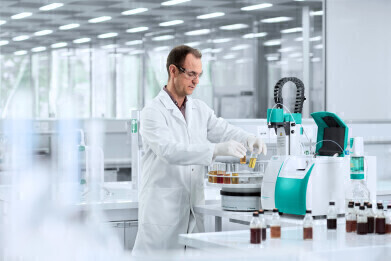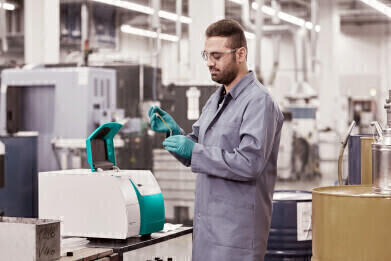Mass Spectrometry & Spectroscopy
Metrohm Offers Complete Solutions for Oil Condition Monitoring
May 31 2023
Monitoring the quality of hydraulic and lube oils is critical to safeguard the availability and prevent premature wear of expensive machinery. Metrohm offers complete solutions for the fast and accurate analysis of key parameters such as moisture, TAN and TBN, remaining antioxidant content, and many others. These parameters can be determined by Karl Fischer titration, titration, near-infrared spectroscopy, and voltammetry, respectively – established techniques that are widely used by QC laboratories in the petrochemical sector and by contract laboratories offering analytical services to the power industry, manufacturers of construction equipment, compressors, or turbines, to name but a few.
Moisture content: automated thermal sample preparation for coulometric Karl Fischer titration
This method is the preferred solution for samples that release the contained moisture only at high temperatures, that are difficult to dissolve, or react with the KF reagent. With this method, the sample matrix is heated up to release the contained moisture, which is then determined by coulometric Karl Fischer titration in a separate reaction vessel: Hence, there are no matrix effects, there is no contamination of the titration cell, and accurate and reproducible results are guaranteed. A blog article explains the features and benefits of this method in detail.
Remaining antioxidant content: voltammetric determination
Testing of in-service lubricants for their remaining antioxidant content is critical for prolonging the uptime of capital equipment as well as reducing running costs and repair expenses. Voltammetry is a fast and established technique for testing the remaining antioxidant content in industrial lubricants. The principle of this method is that the aromatic amines and hindered phenols (which are used as primary antioxidants) in the lubricant sample are extracted into an electrolyte. They are then measured directly in this extraction solution. Voltammetric determination is possible because the hindered phenols as well as aromatic amines contain a functional group that can be electrochemically oxidised. More info about this application can be found in this white paper.
Total Acid Number (TAN) in used engine oil: thermometric titration as per ASTM D8045
Heavily contaminated samples, e.g., used engine or turbine oils, can quickly blog a potentiometric sensor making frequent cleaning and conditioning a must. For such media, thermometric titration can be a better solution. Thermometric titration is the «rugged sibling» of potentiometric titration and can be used for any titration that triggers a change in the temperature of the sample solution during the titration reaction.
How does thermometric titration work? Instead of an electrochemical sensor, thermometric titration follows the titration reaction utilising a thermometer with a very short response time and high resolution. When all the analyte has been reacted with the sample, this sensor registers a minute difference in the rate of temperature change indicating the endpoint of the endo- or exothermic titration reaction. This sensor does not require any maintenance, nor does it need any conditioning, it can be stored dry, and contamination from solid matter in the sample is not an issue since there is no electrode diaphragm. Used oils contaminated with particles are a typical kind of sample that can be analysed by thermometric titration. More info about thermometric titration and more specifically Acid Number as per ASTM D8045 can be found in this blog article.
Multiparameter analysis of lubricants by near-infrared spectroscopy (NIRS)
For lubricant analysis, determination of Acid Number (ASTM D664), viscosity (ASTM D445), moisture content (ASTM D6304), and colour number (ASTM D1500) require the use of multiple analytical technologies and, in part, considerable volumes of solvents and reagents.
NIRS is a non-destructive analytical technology where the sample is investigated as is with no prior sample preparation and chemicals required for analysis. It is faster too than competing technologies and provides results for several physical and chemical QC parameters within a minute. Thus, Acid Number, Base Number, kinematic viscosity, viscosity index, density, colour number, and moisture number can all be determined simultaneously by NIRS, as is described in this blog article.
Digital Edition
Lab Asia 31.2 April 2024
April 2024
In This Edition Chromatography Articles - Approaches to troubleshooting an SPE method for the analysis of oligonucleotides (pt i) - High-precision liquid flow processes demand full fluidic c...
View all digital editions
Events
Apr 28 2024 Montreal, Quebec, Canada
May 05 2024 Seville, Spain
InformEx Zone at CPhl North America
May 07 2024 Pennsylvania, PA, USA
May 14 2024 Oklahoma City, OK, USA
May 15 2024 Birmingham, UK








.jpg)











